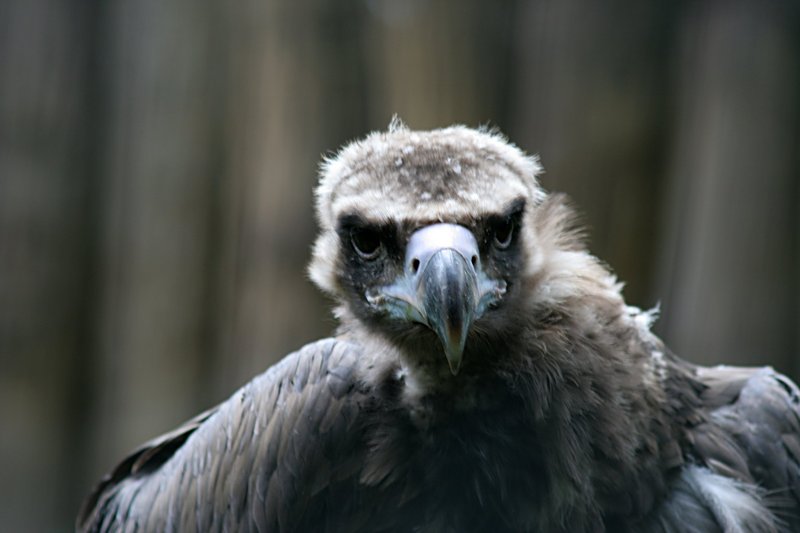|
| 질의: Black kite | 결과: 103번째/147 | |
Eurasian Black Vulture, Cinereous Vulture (Aegypius monachus) - Wiki
| 제목: | Eurasian Black Vulture, Cinereous Vulture (Aegypius monachus) - Wiki
| |

| 해상도: 2400x1600
파일크기: 299755 Bytes
촬영일: 2005:08:22 16:43:55
사진기: Canon EOS 350D DIGITAL (Canon)
F number: f/5.6
Exposure: 1/50 sec
Focal Length: 225/1
등록시간: 2006:12:16 12:15:48
|
Eurasian Black Vulture
From Wikipedia, the free encyclopedia
[Photo] Eurasian Black Vulture at Zoo Praha. photo: che http://commons.wikimedia.org/wiki/User:Che
The Eurasian Black Vulture (Aegypius monachus) is also known as the Monk Vulture, the Cinereous Vulture, or just the Black Vulture. It is a member of the family Accipitridae which also includes many other diurnal raptors such as kites, buzzards and harriers.
This bird is an Old World vulture, and is not related to the New World vultures which are in a separate family Cathartidae. It is therefore also unrelated to the American Black Vulture despite the similar name and coloration.
It breeds across southern Europe and Asia from Spain to Japan, but is endangered throughout its European range. It is resident except in those parts of its range where hard winters cause limited movement.
It is the largest bird of prey (Falconiformes) in the world (as the unrelated, slightly larger Andean Condor is now affiliated with the Ciconiiformes). This huge bird is 110-120 cm (43-48 inches) long with a 250-300 cm (8-10 foot) wingspan and a body mass of up to 14 kg (31 lbs.). It breeds in high mountains and large forests, nesting in trees. It has all dark plumage, and even at a distance can be distinguished from Griffon Vulture by its evenly broad "barn door" wings. It has the typical vulture "bald" head, and dark markings around the eye give it a menacing skull like appearance.
The Eurasian Black Vulture is usually larger than Griffon Vulture. Among the vultures in its range, the Eurasian Black Vulture is best equipped to tear open tough carcass skins, ably using its powerful bill. It dominates all other vultures at carcasses.
http://en.wikipedia.org/wiki/Eurasian_Black_Vulture
| The text in this page is based on the copyrighted Wikipedia article shown in above URL. It is used under the GNU Free Documentation License. You may redistribute it, verbatim or modified, providing that you comply with the terms of the GFDL. |
|
댓글 |
|---|
| | 손님 |
|
Cinereous Vulture
CLASS: Aves
ORDER: Falconiformes
FAMILY: Accipitridae
SUBfamily: Aegypinae
GENUS & SPECIES: Aegypius monachus
CLASSIFICATION: Aigypios (Gr) = vulture; monachos (Gr) = solitary.
RANGE:
Inhabits a broad range from Korea to the Black Sea, with an isolated population in Spain. In winter, range can extend south into the Middle East and Sudan. Prefers mountain forests or scrub lands in most areas, but found in mountain steppes and grasslands on the high plateaus of the Himalayas in Tibet and china.
PHYSICAL DESCRIPTION:
A typical vulture, with featherless head, large strong feet with toe nails not talons, and a strong hooked beak for tearing flesh.
Length: 98 - 107 cm (38 - 42 inches)
Wingspan: 250 - 295 cm (8 - 10 feet)
Weight: 7 - 12.5 kg (15 - 28 pounds)
Coloration: Sooty grey to black. Skin on head and neck bluish grey, pink in juveniles, neck ruff lighter in mature individuals. Blackish down on the head.
DIET:
Wild: Carrion, prefers medium to large carcasses; occasionally will take live prey such as larger lizards and tortoises.
Zoo: Bird of prey diet mix (BOP) and rats, mice or chicken and quail.
ADAPTATION:
Keen eyesight for spotting carcasses - or other vultures that already spotted one. Bald head and neck do not collect bits of rotten tissue. Long broad wings for extended soaring. Heavy bill ideal for tearing through muscles and especially tendons and skin.
Ruff of thick feathers can be pulled up around the head to protect from cold.
BEHAVIOR:
Most populations are resident, though central Asian flocks will follow nomads with domestic ungulate herds. Northernmost populations migrate in winter. |
^o^
동물그림창고 똑똑전화 누리집
^o^
|
|
|

